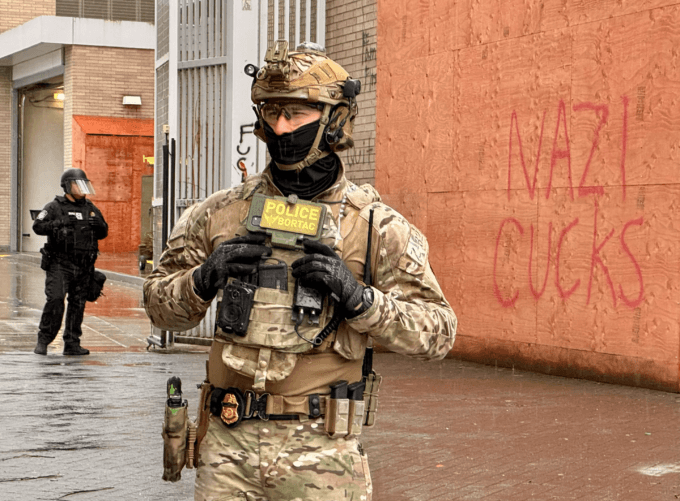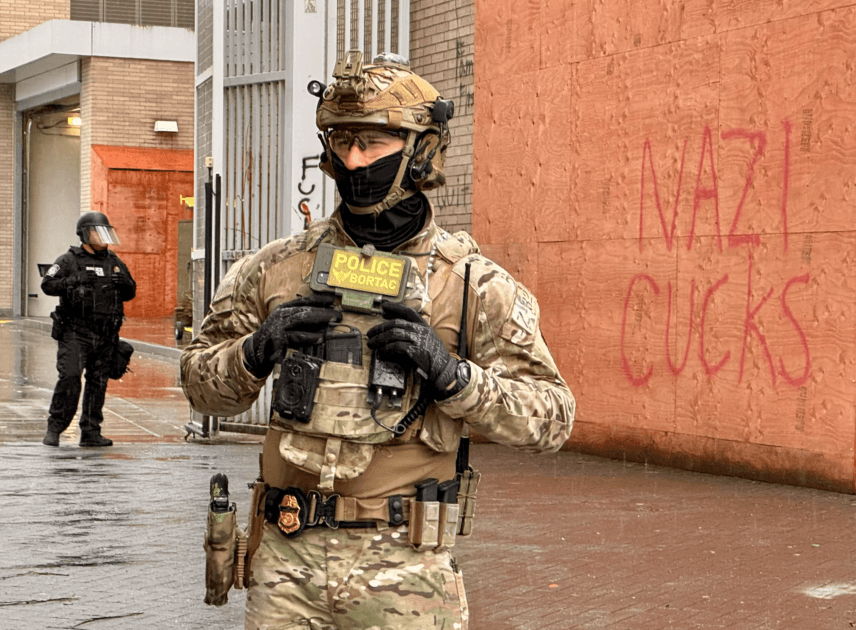






























































Photograph by Nathaniel St. Clair
The Trump administration has sidelined Congress, violated the U.S. Constitution, and taken an axe to both the U.S. and the global economies. Trump has issued executive orders that give him unprecedented presidential powers. The courts have blocked many of his policies, but in the budget bill pending in the Senate, there is a clause buried in the thousand-page document that would make it far more difficult for courts to enforce their judgements against the administration. In front of the Supreme Court, Trump’s lawyers have successfully argued that he has immunity from prosecution for pretty much anything he does when he’s in office.
In this way, Trump has dismantled the structures of U.S. democracy. You might think that all of these actions taken together amount to a declaration of martial law. But they don’t. The United States remains, at least formally, a civil democracy, and the president must still answer to other institutions (Congress, the courts).
However, Trump continues to test the limits of his power, and now he is doing so with respect to the military. He is doing so either to govern just short of a martial law declaration—or in preparation to make that declaration at some future date.
Although formally the commander-in-chief of the armed forces, the president is constrained by tradition and by law from deploying the military however he pleases. In his first term, Trump nevertheless attempted to use the military as a tool of presidential power. He tried to arrange a military parade in Washington, DC. He proposed to use the military against Black Lives Matter demonstrators around the country in the wake of George Floyd’s murder in 2020. The military said no. His defense secretaries—Jim Mattis and then Mark Esper—opposed these proposals.
In his second term, Trump has replaced career military with loyalists. For the head of the Pentagon, he appointed Pete Hegseth, an incompetent ideologue and former Fox News host. And now it seems that the military is willing to do Trump’s bidding. On June 14, the president will get the military parade he has so desperately wanted—to celebrate the two-hundred-and-fiftieth anniversary of the Army and his own seventy-ninth birthday. Kim Jong Un would be envious.
More consequentially, using the Insurrection Act of 1792, Trump dispatched National Guard troops and U.S. Marines to Los Angeles to suppress demonstrations against the actions of Immigration and Customs Enforcement (ICE). What Trump is doing is technically unconstitutional for the president can’t send the army to participate in policing.
But the constitutionality of Trump’s actions is secondary to the scale of his ambition. On the face of it, Trump wants to ramp up deportations. He knows that he will have to confront the political leadership of Democrat-controlled cities and states. He will have to overcome public resistance to ICE raids on workplaces, churches, and schools. He will also have to confront some of his own allies in business—in construction, agriculture, and the service sector—who will be deprived of their workforce.
But in many ways, Trump’s use of the military is far more ambitious. He is using the immigration issue as a pretext to expand his control over public institutions and legitimate the unconstitutional suppression of the freedoms of speech and assembly. He has promised to send the National Guard to cities across the United States to suppress protest, and he hasn’t made much of a distinction between violent and non-violent demonstrations.
In other words, this is a form of slow-motion martial law. It is less a declaration than an evolving action.
Trump’s expanding control of the military extends to the foreign policy realm. Despite his promises to learn the lessons of the Iraq War, Trump is now thinking about joining Israel’s war against Iran. He has called on Iran to surrender unconditionally and is considering the use of U.S. bunker-busters to destroy the country’s underground nuclear facilities. Iran has threatened to retaliate against U.S. bases in the Middle East.
Americans are not meekly accepting Trump’s autocratic moves. His military parade coincided with thousands of “No Kings” demonstrations across the country that turned out millions of protestors. These are not partisan events. Many independents and even a few Republicans are appalled at Trump’s flirtation with martial law. And Trump’s threats against Iran have split his own MAGA camp.
Congressional Democrats by and large oppose Trump, but they don’t control enough votes to make much difference. If Trump’s budget bill fails to pass the Senate—it already passed the House by a single vote—it will be because it doesn’t cut enoughgovernment services for deficit hawks in the Republican Party.
In California, however, Governor Gavin Newsom has emerged as perhaps the most prominent critic of the president. He has correctly diagnosed the presidential dispatch of the National Guard—without his approval—not just as a powerful violation of the constitution but as the moment when Trump is attempting to seize absolute power. “The rule of law has increasingly been given way to the rule of Don,” the governor said in a recent speech.
In South Korea, when Yoon Suk-yeol infamously declared martial law in December 2024, parliamentarians and ordinary people immediately fought back. They managed to reverse martial law in a matter of hours, and Yoon was subsequently impeached. The Constitutional Court upheld the impeachment, and new elections were called. One of the parliamentarians who courageously pushed back against martial law, Lee Jae Myung, was elected president this month by a comfortable margin.
Trump knows that a declaration of martial law in the United States would trigger similar—through perhaps not similarly effective—protests. He doesn’t feel the need to make a formal declaration if he can achieve what he wants under the current system. He has already invoked a number of emergencies to assume extraordinary powers.
In South Korea, martial law was undone by public protest. In the United States, Trump will reverse the equation and use martial law to overcome public protest. He anticipates that his current actions—to deport a million people, to cut government services—will unleash massive protests. If he can’t suppress those protests through “ordinary” means, he will use martial law as his trump card.
It might seem an impossible dilemma for the resistance movement in the United States. Don’t protest now for fear that the president will declare martial law or protest now and increase the chances of such a declaration.
Trump projects strength. But an autocrat secure in his power doesn’t organize a military parade on his own birthday. Deep down, Trump knows that a majority of Americans don’t support him, that the courts consistently rule against him, that major institutions in society like universities, the press, and Hollywood hold him contempt. Trump is, in fact, a weak man who doesn’t even have the courage of his (few) convictions. His latest nickname is TACO: Trump Always Chickens Out.
So, protest is the only answer to Trump’s actions even if it risks a declaration of martial law. It is important to force Trump’s hand and make him say in public what everyone already knows: that he is an autocrat who wants to destroy American democracy.
Originally published in Hankyoreh.
The post Martial Law in the United States appeared first on CounterPunch.org.
This post was originally published on CounterPunch.org.